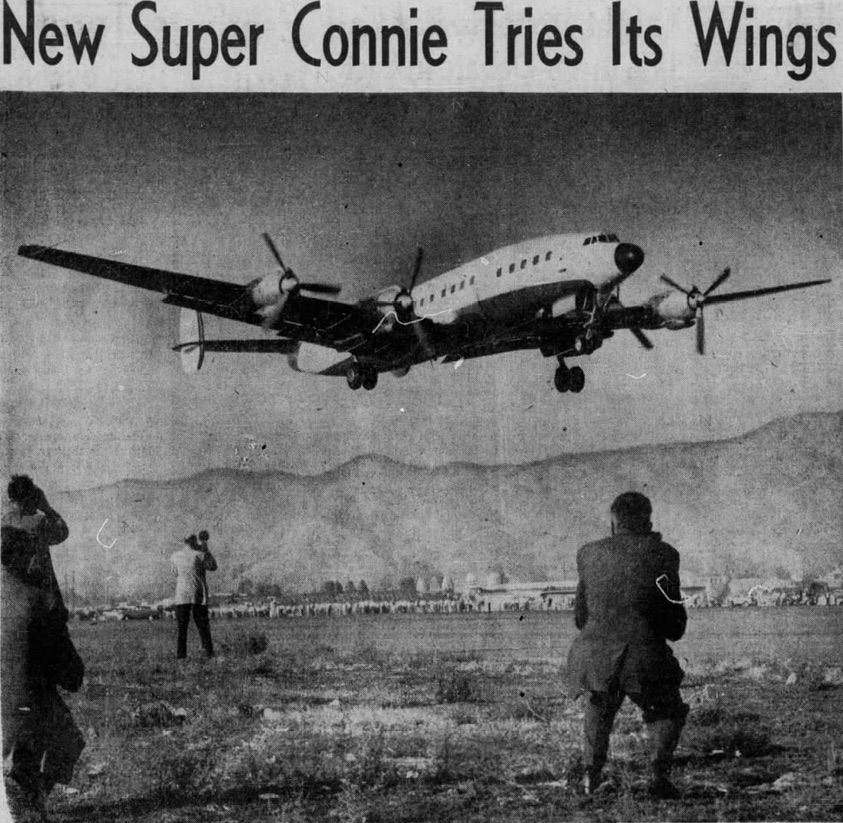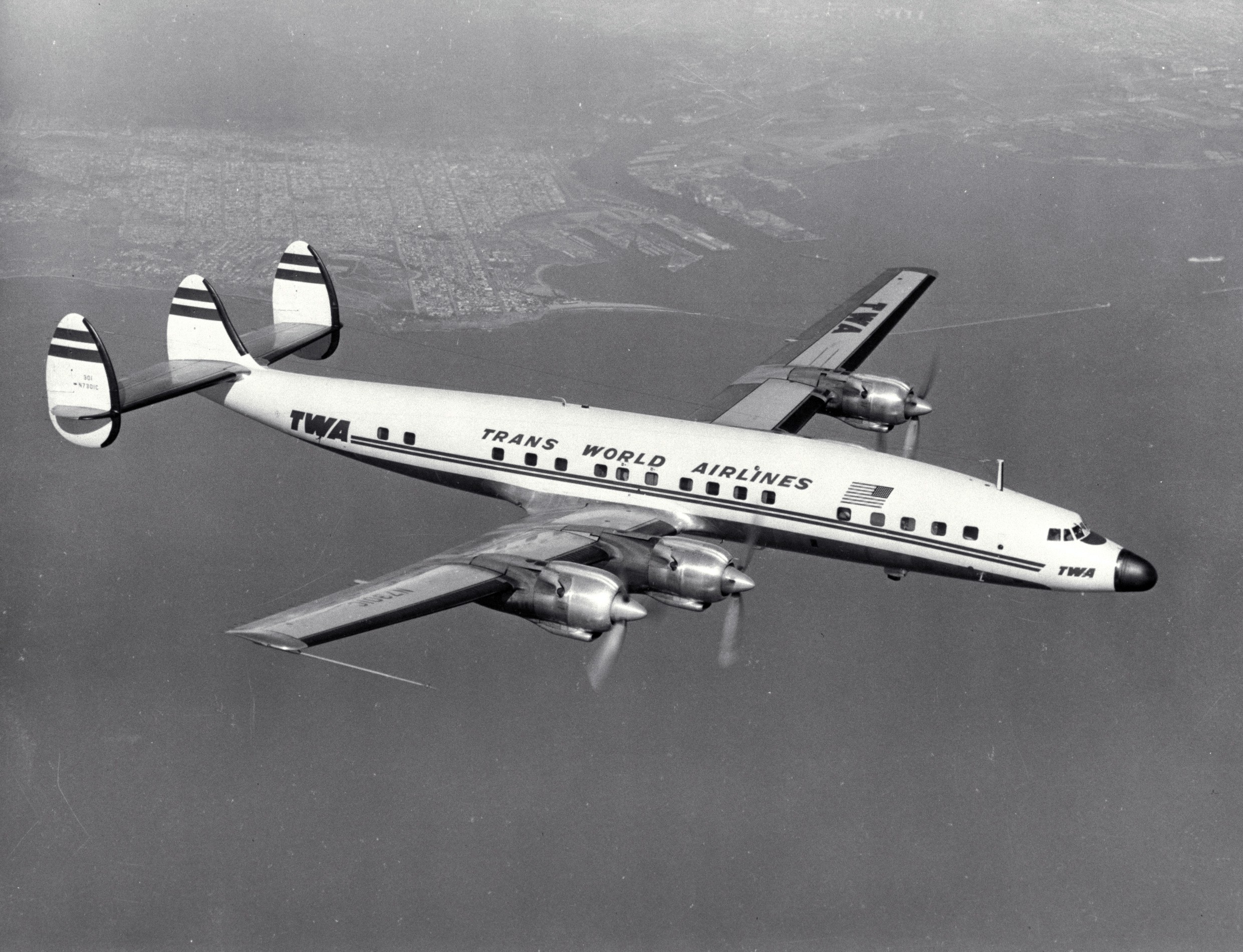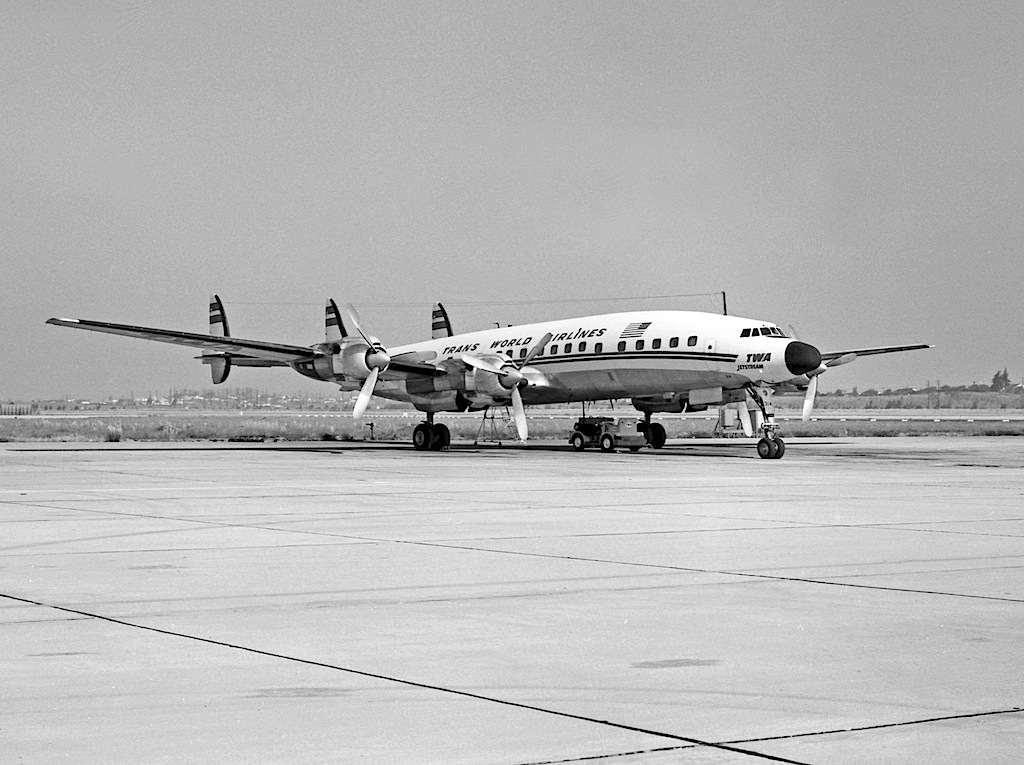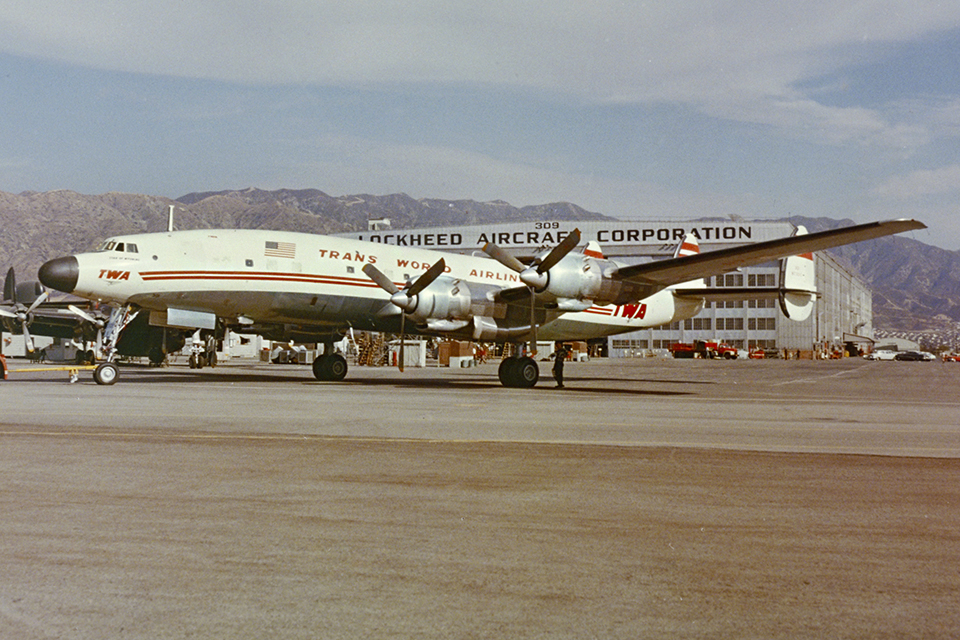
10 October 1956: At 4:15 p.m., after a 20-second ground run, the prototype L-1649 Starliner lifted off from Lockheed Air Terminal, Burbank, California. On the flight deck were company test pilots Herman Richard (“Fish”) Salmon and Roy Edwin Wimmer. The flight engineer was Glenn Fisher, and John Stockdale served as the flight test engineer.
“The ground shook as the big Connie climbed gracefully away. Its wings glistened in the late-afternoon sunlight like long, slender knife blades. They measure 150 feet, or 27 feet more than on previous Super Constellations. Gross takeoff weight is 156,000 pounds. The plane is powered by four 3400 h.p. turbo-compound engines.”
—Los Angeles Times, Vol. LXXV, Thursday, 11 October 1956, Part 1, Page 5, Column 5
After a 50-minute flight, the new airliner returned to Burbank. When asked, one of the pilots said, “It handles real smooth.”
The prototype Lockheed L-1649 Starliner, c/n 1001, registered N60968, was a major improvement over the previous model the L-1049 Super Constellation. Using the fuselage of the L-1049G variant, a new low-drag wing was used. The wing was about 16% thinner than the previous design, and had a span increased to 150 feet. By designing the main landing gear to retract into the inner engine nacelles rather than into openings in the lower surface of the wing, the wing could be built much stronger. The wing tips were squared.
The airliner’s fuel capacity, 9,600 gallons (36,340 liters), was sufficient for it to stay aloft for 24 hours. It was designed to carry 58 passengers 6,300 miles (10,139 kilometers) at 350 miles per hour (563 kilometers per hour).
The first production L-1649A, c/n 1002, was built for Trans World Airlines and registered N7301C. TWA called its Starliners “Jetstreams.”

Lockheed and TWA had considered using turboprop engines (this would have been designated L-1549), but reliability, poor fuel efficiency and cost resulted in continuing to use Wright’s reciprocating Duplex-Cyclone radials.
The L-1649A was powered by four air-cooled, supercharged and fuel-injected 3,347.662-cubic-inch-displacement (54.858 liter) Wright Aeronautical Division Turbo Compound 988TC18EA2 18-cylinder radial engines. The engine’s high-velocity exhaust gases drove three “blow down” turbines which were geared to the engine’s crankshaft. (Gear reduction is 6.52:1.). Energy that would otherwise be wasted added as much as 600 horsepower to each engine. The Turbo Compound used the same nose section, power section and rear section as the standard Cyclone 18CB. The 988TC18EA2 was rated at 2,800 horsepower at 2,600 r.p.m., and 3,400 horsepower at 2,900 r.p.m. for takeoff. It had a compression ratio of 6.7:1 and required 115/145-octane aviation gasoline. The Turbo Compound engine was 7 feet, 5.53 inches (2.274 meters) long, 4 feet, 8.59 inches (1.437 meters) in diameter, and weighed 3,745 pounds (1,699 kilograms). The engines drove three-bladed Hamilton Standard propellers with a diameter of 16 feet, 10 inches (5.131 meters) through a 0.355:1 gear reduction.

44 production L-1649A Starliners were built by Lockheed in 1957 and 1958. The original L-049 prototype, NC25600, having previously modified as the prototype L-749 Constellation, L-1049 Super Constellation and PO-1W Warning Star, was also converted to the L-1649A configuration.
The prototype L-1649 was retained by Lockheed until withdrawn from service in 1971. Sold to M-K Aerospace Industries, in January 1973, it was re-registered as a L-1649A-98, N1102, and exported to Japan. It is reported to have been scrapped in December 1982.

© 2020, Bryan R. Swopes
An extraordinary plane. starliner L-1649 A
EL STARLINER L-1649 A, UN GRAN AVIÓN !!!
Was there ever a more beautiful airliner?
it is ironic that Fish Salmon was kulled in trying to make a ferry flight in a L-1049h Super Constellation N74CA on June 22,1980 from Columbus , Indiana to Seattle Washington. https://aviation-safety.net/database/record.php?id=19800622-0
No!
Best flight I ever had was on a TWA Jetstream from Idlewild to San Francisco in 1958. Best service – super smooth. For a 14 year old, sold me on an aviation career. Had a Super G from Vancouver to Montreal through Ottawa a week earlier. TWA was the best.
I flew from Columbus Ohio to San Fran. in 1957 on a TWA flite that was a piece of cake flite, smooth no turbulence great food, and very comfortable seats.
In 1959, a Connie was our return flight from London. I was 11 (my first flight), but seemed to remember thinking the engines were turbo-prop from the sound of them. Would the turbo-enhanced Super Connie have made that jet-like noise? Also, anybody know what other prop planes TWA ran going to Paris? I’d love to I.D. our out-bound plane (also radials, I believe). Thanks.
Super Constellations used turbo-compound engines. Each engine had three turbines which were hydraulically coupled to the crankshaft and produced an additional 400 horsepower.
If you can forgive me an idea if the date and the time of day, l should be able to dig it out.
The L-1649A Starliner was unusually quiet for a propliner. Possibly, if you were seated up front, you might have heard more the sound of wind, which is more noticeable up front. TWA referred to their Starliners as “Jetstreams”. In 1959 TWA’s trans-Atlantic flights were served exclusively by Jetstreams. Check out Airline Timetable Images on the internet. There you will find the actual timetables and find out what equipment was scheduled by every airline on any given year. Incidentally, I was fortunate to have flown a Starliner as co-pilot back in 1980. That same plane, N8083H, is today a cocktail lounge at the old TWA terminal at JFK.
Great story
Used to supply the Blue Angels on tour. Great Experience!
That was a Lockheed C-121J Super Constellation (L-1049)
Beautiful aeroplane. I’m surprised though at the suggestion that the turbo-compound engines were more reliable than turbo-props. I doubt if that opinion would stand up to hindsight experience. That said, they certainly were at the pinnacle of civil aviation piston engines.